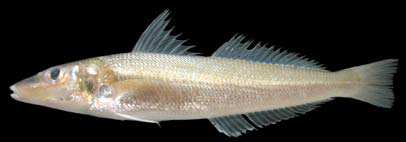| SILLAGINIDAE |

Sillago sihama, 16.0 cm SL
(photo by Seishi Kimura)
|
Sillago sihama (Forsskål, 1775) Silver Sillago |
|
D XI+I, 20-23; A II, 21-23; LLp 66-72. Body elongate, subcylindrical, covered with ctenoid scales; first pelvic-fin ray normal, not thickened clublike structure; swimbladder with two anterior and two posterior extensions; anterior extensions extend forward and diverge to terminate on each side of the basioccipital above the auditory capsule; two lateral extensions commence anteriorly, each sending a blind tubule anterolaterally and then extending along the abdominal wall below the investing peritoneum to just posterior of the duct-like process; two posterior tapering extensions of the swimbladder project into the caudal region, one usually longer than the other; vertebrae 14 + 2-8 + 12-18 (total 34). Color: body light tan, silvery yellow-brown, sandy brown, or honey colored; paler brown to silvery white below; a midlateral, silvery, longitudinal band normally present; dorsal fins dusky terminally with or without rows of dark brown spots on the second dorsal-fin membrane; caudal fin dusky terminally; no dark blotch at base of pectoral fins; other fins hyaline; anal fin frequently with a whitish margin. Size: maximum standard length about 30 cm. Distribution: Indo-West Pacific: Red Sea and Knysna (South Africa) to Japan and south to Australia. Remarks: Common along beaches, sandbars, mangrove creeks and estuaries. Feeds mainly on polychaete worms, small prawns, shrimps and amphipods. |
|
|